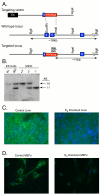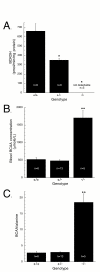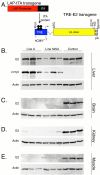Production and characterization of murine models of classic and intermediate maple syrup urine disease
- PMID: 16579849
- PMCID: PMC1448208
- DOI: 10.1186/1471-2350-7-33
Production and characterization of murine models of classic and intermediate maple syrup urine disease
Abstract
Background: Maple Syrup Urine Disease (MSUD) is an inborn error of metabolism caused by a deficiency of branched-chain keto acid dehydrogenase. MSUD has several clinical phenotypes depending on the degree of enzyme deficiency. Current treatments are not satisfactory and require new approaches to combat this disease. A major hurdle in developing new treatments has been the lack of a suitable animal model.
Methods: To create a murine model of classic MSUD, we used gene targeting and embryonic stem cell technologies to create a mouse line that lacked a functional E2 subunit gene of branched-chain keto acid dehydrogenase. To create a murine model of intermediate MSUD, we used transgenic technology to express a human E2 cDNA on the knockout background. Mice of both models were characterized at the molecular, biochemical, and whole animal levels.
Results: By disrupting the E2 subunit gene of branched-chain keto acid dehydrogenase, we created a gene knockout mouse model of classic MSUD. The homozygous knockout mice lacked branched-chain keto acid dehydrogenase activity, E2 immunoreactivity, and had a 3-fold increase in circulating branched-chain amino acids. These metabolic derangements resulted in neonatal lethality. Transgenic expression of a human E2 cDNA in the liver of the E2 knockout animals produced a model of intermediate MSUD. Branched-chain keto acid dehydrogenase activity was 5-6% of normal and was sufficient to allow survival, but was insufficient to normalize circulating branched-chain amino acids levels, which were intermediate between wildtype and the classic MSUD mouse model.
Conclusion: These mice represent important animal models that closely approximate the phenotype of humans with the classic and intermediate forms of MSUD. These animals provide useful models to further characterize the pathogenesis of MSUD, as well as models to test novel therapeutic strategies, such as gene and cellular therapies, to treat this devastating metabolic disease.
Figures




References
-
- Chuang D, Shih V. Maple Syrup Urine Disease (Branched-Chain Ketoaciduria) In: Scriver C, Beaudet A, Sly W, Valle D, Childs B, Kinzler K, Vogelstein B, editor. The online metabolic & molecular bases of inherited disease. 8. New York: McGraw-Hill Medical Publishing; 2001. pp. 1971–2005.
-
- Marshall L, DiGeorge A. Maple syrup urine disease in the old order Mennonites. Am J Hum Genet. 1981;33:139a.
-
- Paul H, Adibi S. Role of ATP in the regulation of branched-chin a-keto acid dehydrogenase activity in liver and muscle of fed, fasted, and diabetic rats. J Biol Chem. 1982;257:4875–4881. - PubMed
Publication types
MeSH terms
Substances
Grants and funding
LinkOut - more resources
Full Text Sources
Other Literature Sources
Medical
Molecular Biology Databases
Research Materials

